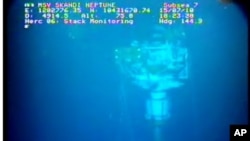BP says it has stopped the flow of oil from a ruptured well in the Gulf of Mexico as part of a pressure test. Engineers plan to continue the test for as long as 48 hours.
BP engineers began the pressure test on Thursday. It involves closing a series of valves on the wellhead to stop the flow of oil and natural gas.
The operation is intended to measure the pressure inside the well pipe that runs nearly four kilometers beneath the floor of the Gulf of Mexico.
"I'm very pleased there is no oil going into the Gulf of Mexico," said BP Senior Vice President Kent Wells. "In fact, I'm very excited there is no oil going into the Gulf of Mexico. Where I'm holding back my emotions is we are just starting the test and I don't want to create a false sense of excitement."
Officials say they hope to conduct the pressure test over a 48-hour period to get as much data as possible. But they say they might stop the test early, if pressure measurements are very low.
U.S. Coast Guard Admiral Thad Allen is overseeing the response to the oil well leak.
"The only reason we would terminate the test quickly is if we had a very low pressure reading," he said. "That would be indicative of the fact that oil was being released somewhere in the well bore out into the formation. We would not want that. But as pressure continues to rise, we will continue to monitor it."
BP engineers say the pressure test was possible after a new containment cap was placed on the damaged wellhead in recent days. For several weeks, crews had been using a loose-fitting cap to siphon oil from the well into surface ships. But the new cap allows for a tighter fit, which might enable BP to shut down the leaking well for good.
BP's Kent Wells says engineers are looking at all options, but that the current plan for stopping the leak is to use another operation called "bottom-kill."
"No decision has been made on whether we try anything different," he said. "The plan as of today is to continue forward with the relief wells and kill the well from the bottom."
BP says an offshore platform is drilling a relief well that is closing in on the damaged well to prepare for the bottom-kill operation. The procedure involves penetrating the original well near the base and filling the drill pipe with heavy mud to stop the flow of oil and natural gas.
Officials say they might be ready to conduct that operation in about a month.
Related video report by Mil Arcega:










